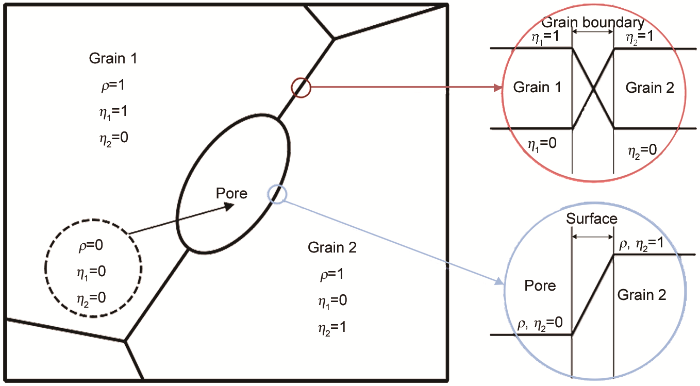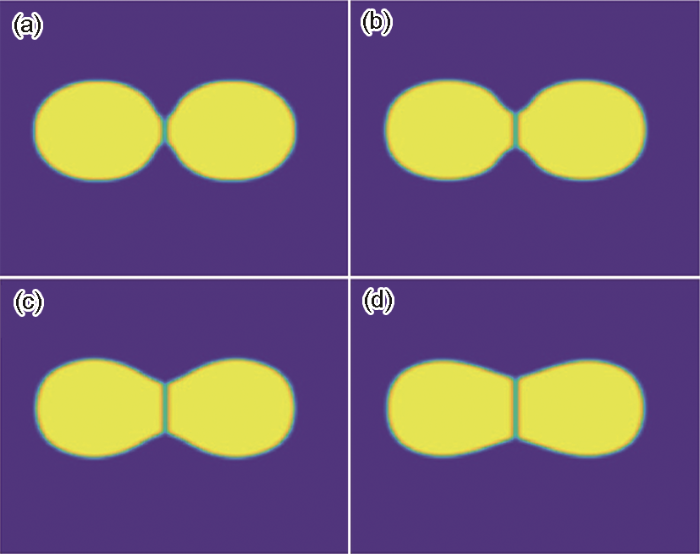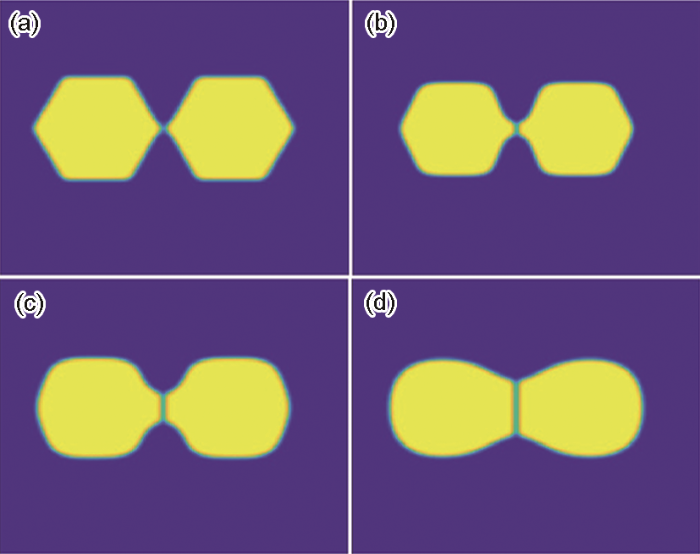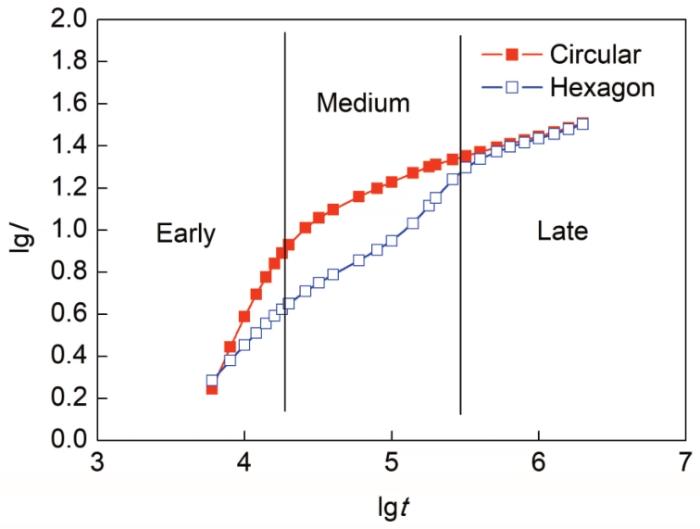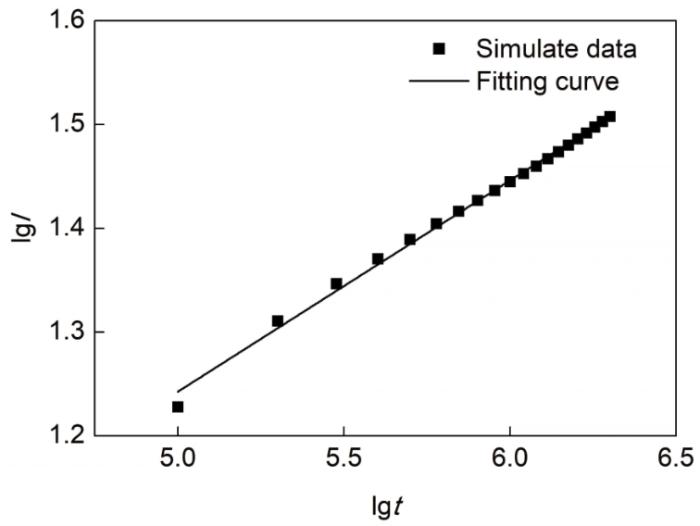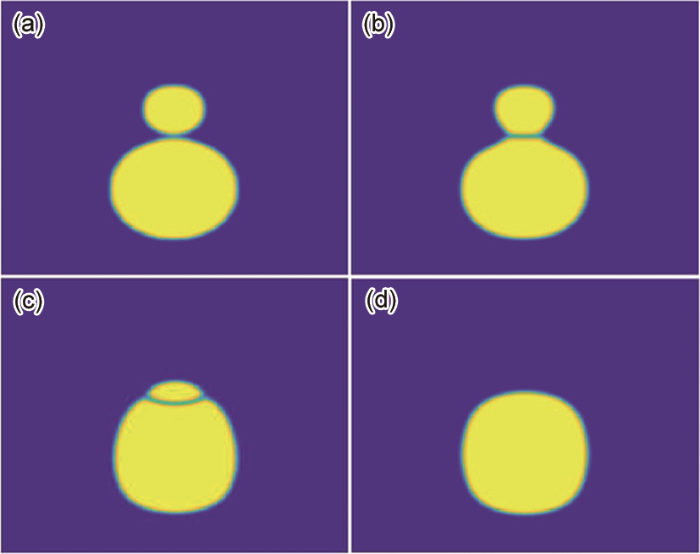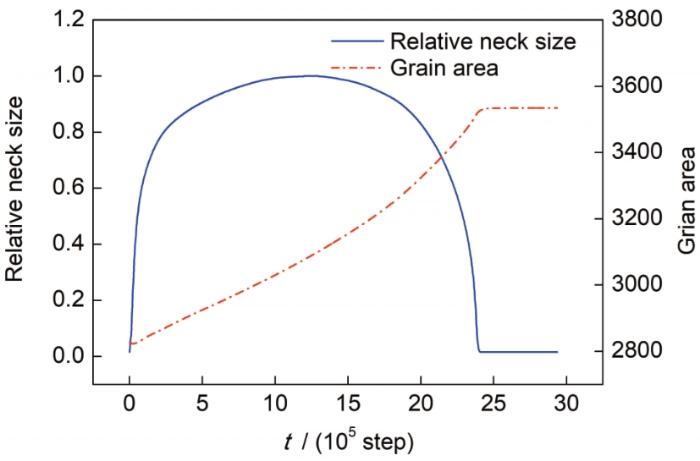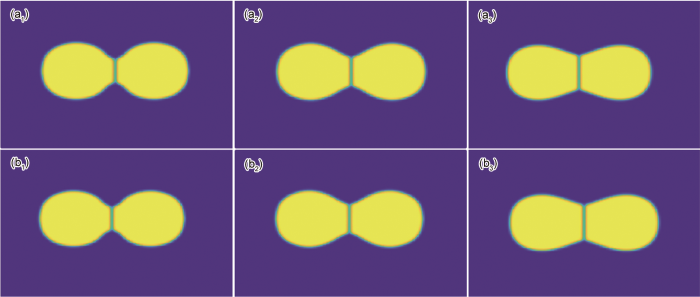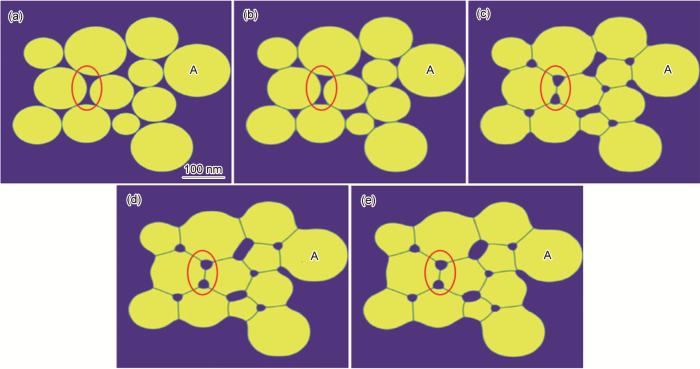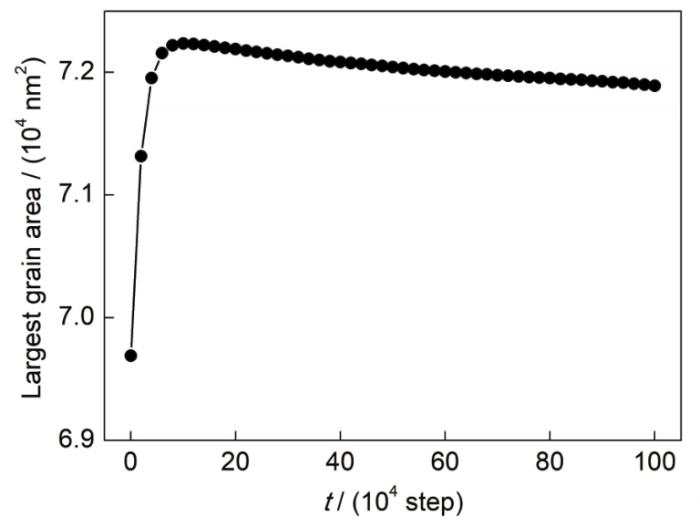核燃料堪称核反应堆的“心脏”,是各种反应堆的核心部件之一;二氧化铀(UO2 )作为一种传统的氧化物陶瓷燃料,被广泛用于各种反应堆[1 ,2 ] 。目前,UO2 燃料芯块制备的核心仍然是其粉末的高温烧结工艺。然而,陶瓷材料在高温下的烧结过程十分复杂,涉及到多种同时发生的质量传输机制[3 ~7 ] 。烧结过程的扩散机制主要有表面扩散、晶界扩散和晶格扩散3种。这3种扩散机制的传质途径不同,其中表面扩散发生在晶粒与气孔接触的表面,晶界扩散发生在晶界,晶格扩散发生在晶格内的缺陷。一般认为,表面扩散比晶界扩散快,晶界扩散比晶格扩散快。研究[3 ,4 ] 表明,3种扩散机制的强弱与陶瓷粉末的种类、烧结的温度及烧结的时间等因素密切相关。在陶瓷粉末的烧结过程中,3种扩散机制共同作用导致烧结颈的形成,随着烧结颈的不断增长,烧结过程逐渐完成。因此,深入理解烧结过程中的3种扩散机制对揭示陶瓷粉末的烧结机理至关重要。
近年来,国内外学者针对陶瓷粉末烧结过程的数值模拟展开了一系列研究工作。目前,描述陶瓷粉末烧结过程的理论模型主要有Monte Carlo模型[8 ,9 ] 、元胞自动机模型[10 ] 、尖锐界面模型[11 ~13 ] 和相场模型[14 ~19 ] 。其中,相场模型基于扩散界面模型[20 ] ,引入了一系列有序变量来区分不同取向的晶粒和气孔相,相场变量在晶界和气孔表面处连续变化。因此,利用相场模型可以有效地追踪烧结过程中的复杂界面的演变过程,进而更高效地揭示其烧结微观组织演变。目前,包括有限差分方法[14 ~16 ] 、有限元方法[17 ~19 ] 在内的多种数值算法已经被应用于求解相场模型。因此,以相场理论为基础,对陶瓷粉末的烧结过程展开研究非常有意义。
最近,相场模型已经被应用于模拟陶瓷粉末的烧结过程,并取得了一些初步的结果。景晓宁等[21 ] 模拟了含孔隙陶瓷的烧结过程,模拟显示了陶瓷颗粒间黏结、烧结颈形成、生长和气孔变形及球化等一系列微观过程。刘明治等[22 ] 应用相场模型进一步模拟两相含气孔组织的烧结。Wang[23 ] 将刚体的平移和旋转效应纳入了陶瓷粉末烧结过程的相场模型,研究了扩散机制对烧结的影响。Kumar等[24 ] 模拟了2个不等大的小颗粒的烧结过程,得到了烧结不同阶段晶界的迁移规律。Gugenberger等[25 ] 和Moelans等[26 ] 对相场方程进行修正,提出了张量形式的迁移率系数;Deng[27 ] 的模拟证明了张量形式的迁移率系数会对扩散方向产生约束,使其局限在界面的切线方向。然而,不同扩散机制在UO2 陶瓷粉末烧结过程中的作用有待进一步澄清,陶瓷粉末的晶界能对烧结组织形貌和烧结动力学的影响尚未被考虑。
本工作在上述相场模型的基础上,对现有的描述陶瓷粉末烧结过程的相场模型进行了修正。在新模型中,不仅采用张量的形式考虑了3种各向异性的扩散机制(表面扩散、晶界扩散和晶格扩散),而且考虑了不同陶瓷颗粒(晶粒)之间的界面能。在新模型的基础上,结合UO2 在2000 K烧结时的物理参数和实验结果,分别对UO2 “双晶粒”和“多晶粒”的烧结过程进行了研究模拟。
1 相场模型
1.1 相场变量
本工作通过引入一系列取向场变量ηi (i =1, 2, 3, ⋯ p )和浓度场变量ρ 来描述不同取向的陶瓷粉末(或晶粒)和气孔相。其中,η 为非保守型相场变量,用来描述不同晶粒的取向,在一个特定的晶粒中只有一个ηi 取值为1,其余均为0;ρ 为保守型相场变量,在气孔相内部,ρ 的取值为0, 在基体内ρ 的取值为1。图1 为扩散型相场界面的示意图,图中红色圆圈指出了相邻2个晶粒的晶界,蓝色圆圈指出了晶粒与气孔的边界。可以看出,在晶界处ηi 的取值从1连续变为0 (或者由0变为1),在气孔边界处,ρ 的取值从0连续变化为1。
图1
图1
相场模型示意图
Color online
Fig.1
Schematic of phase field model (The red and blue circles represent diffuse boundaries between grain boundaries, and between pore and grain, respectively. ρ— concentration field variable, η 1 — orientation field variable of grain 1, η 2 — orientation field variable of grain 2)
相邻2个晶粒之间的取向角θi (i =1, 2, 3, ⋯ p )可以用来描述晶粒的不同取向,而晶界两侧相邻2个晶粒i j θij (min(|θi -θj |),180°-|θi -θj |)与该晶界的晶界能密切有关。Read和Shockley[28 ] 提出的RS模型建立了各向异性晶界能γ i j g b θ i j
γ i j g b = γ m g b θ i j θ m 1 - l n θ i j θ m θ i j θ m < 1 γ m g b θ i j θ m ≥ 1 (1)
式中,γ i j g b i 与晶粒j 之间的晶界能;γ m g b θ m 为取向差的最大值,对于RS模型而言θ m =20°。
1.2 自由能密度函数的构造
本工作中陶瓷粉末烧结过程的相场模型所采用的体系总的自由能F
F = ∫ f ρ , η 1 , η 2 , ⋯ , η p + κ ρ 2 ∇ ρ 2 + κ η 2 ∑ i = 1 p ∇ η i 2 d 3 r (2)
式中,f 为体自由能密度函数;κ ρ 2 ∇ ρ 2 κ η 2 ∑ i = 1 p ∇ η i 2 κρ 和κη 为参数,取决于材料界面的具体的物理参数;r 为空间坐标。
f ρ , η i = A ρ 2 1 - ρ 2 + B ρ 2 + 6 1 - ρ ∑ i η i 2 - 4 ( 2 - ρ ) ∑ i η i 3 + 3 ( ∑ i η i 2 ) 2 (3)
式中,A 和B 为与材料物理参数有关的参数。该形式的f 能够保证在各个晶粒的内部和气孔内部取得极小值,因而共有(p +1)个极小值。上述形式的自由能函数中各常数与材料的物理参数之间的关系如下[29 ] :
A = 12 γ s - 7 γ g b δ (4)
B = γ g b δ (5)
κ η = 3 γ g b δ 4 (6)
κ ρ = 3 2 γ s - γ g b δ 4 (7)
式中,γ gb 和γ s 分别代表材料的晶界能和表面能;δ 代表扩散界面的宽度。
1.3 相场演化的动力学方程
上述相场模型中ρ 的演化动力学方程为Cahn-Hilliard扩散方程[30 ] :
∂ ρ ∂ t = ∇ ⋅ M ∇ δ F δ ρ (8)
M = ν m D R T (9)
式中,ν m R 表示气体常数;T 表示温度。
由于体系中的扩散机制包括表面扩散、晶界扩散和体扩散。因此,可以认为D D s +D gb +D l ,其中,D s 、D gb 、D l 分别为表面扩散系数张量、晶界扩散系数张量、晶格扩散系数张量,表达形式分别如下[29 ] :
D s = D s ρ 2 1 - ρ 2 T s (10)
T s = I - n s ⊗ n s (11)
n s = ∇ ρ ∇ ρ (12)
式中,D s 是表面扩散系数标量,对于UO2 ,D s =50×exp(-450000/(RT ))[31 ] ;T s 是表面投影张量,保证表面扩散仅发生在晶粒与气孔接触表面的切线方向;I n s 为表面单位法向量。
D g b = D g b ∑ i = 1 p ∑ j > i p η i η j T g b (13)
T g b = I - n g b ⊗ n g b (14)
n g b = ∇ η i - ∇ η j ∇ η i - ∇ η j (15)
式中,D gb 是晶界扩散系数标量,对于UO2 ,D gb =1.38×10-6 ×exp(-239000/(RT ))[32 ] ;T gb n gb 为晶界单位法向量。
D l = D l ξ ρ I (16)
ξ ρ = ρ 3 10 - 15 ρ + 6 ρ 2 (17)
式中,D l 是晶格扩散系数标量;ξ (ρ )为插值函数,可以保证晶格扩散发生在固相晶粒的内部和表面。
ηi 的演化方程为Allen-Cahn方程[30 ] :
∂ η i ∂ t = - L δ F δ η i = - L ∂ f ρ , η 1 , η 2 , ⋯ , η p ∂ η i - κ i ∇ 2 η i
( i = 1 , 2 , ⋯ , p ) (18)
式中,L 是Allen-Cahn迁移系数,L 与材料具体物理参数的关系如下[33 ] :
L κ η = γ g b M b (19)
M b = ν m D a R T δ (20)
D a = D g b / 10 (21)
通过联立求解Cahn-Hilliard扩散方程和Allen-Cahn方程就可以得到所有相场变量随时间的演化关系。但为了直观地显示出UO2 晶粒的烧结过程,本工作引入一个可视化变量φ [16 ] :
φ = ∑ i η i 2 (22)
结合扩散界面的特征可知:在晶粒内部φ φ φ φ
常用的求解上述相场方程的数值方法主要有3种,分别为有限差分方法、有限元方法和Fourier Spectral方法。本工作基于有限差分方法通过编写程序进行模拟,Allen-Cahn方程和Cahn-Hilliard方程的求解采用了显式Euler算法,方程中Laplace项的求解采用了五点差分法。
2 模型的无量纲化
利用相场模型对UO2 陶瓷粉末在2000 K温度下的烧结过程进行了数值模拟,模拟中用到的UO2 的物理参数如表1 [31 ,32 ,34 ] 所示。
为便于计算机进行数值模拟,需对相场方程中的变量和常数进行无量纲化处理。这一过程需要先选取一组参考物理量,然后用模型中变量除以参考量得到一组没有单位的无量纲量。本工作所选取的参考量如下:
ε * = B t * = 1 L ε * l * = δ m (23)
式中,ε * t * l * m 为扩散界面在模拟中所占的格点数,本工作取m =3。
将式中参考量代入演化方程(8)和(18),得到其无量纲形式如下:
∂ ρ ∂ τ = ∇ ˜ ⋅ M ˜ ∇ ˜ δ F ˜ δ ρ (24)
∂ η i ∂ τ = - δ F ˜ δ η i (25)
式中,τ = t / t * ∇ ˜ = l * ∇ M ˜ M ˜ = M ˜ s + M ˜ g b + M ˜ l M ˜ s M ˜ s = 3 4 D s D a m 2 ,M ˜ g b M ˜ g b = 3 D g b 4 D a m 2 ,M ˜ l M ˜ l = 3 D l 4 D a m 2 );F ˜ A 、B、 κ ρ 和 κ η A ˜ B ˜ κ ˜ ρ κ ˜ η
A ˜ = A ε * = 12 γ s - 7 γ g b γ g b B ˜ = B ε * = 1 κ ˜ ρ = κ ρ ε * l * 2 = 3 4 2 γ s - γ g b γ g b m 2 κ ˜ η = κ η ε * l * 2 = 3 4 m 2 (26)
将UO2 的物理参数代入上述方程中,求得各无量纲参数的具体数值如表2 所示。
3 结果与讨论
3.1 双晶粒的烧结过程
利用相场模型,采用双晶粒结构对UO2 陶瓷粉末的烧结过程进行模拟。模拟区域差分网格尺寸为256×256,采用周期性边界条件。分别研究晶粒形状、晶粒尺寸、不同扩散机制和晶界能各向异性等4个因素对UO2 陶瓷粉末烧结组织演变过程的影响。
3.1.1 晶粒形状的影响
图2 和3分别为2个等尺寸的圆形颗粒和2个等尺寸的六边形颗粒在烧结过程中形貌演变的相场模拟。其中圆形颗粒的直径为60个格点,六边形晶粒的最长对角线为60个格点,该选择可以确保2个“颗粒”的中心点之间的距离保持一致。可以看出,圆形晶粒与六边形晶粒烧结过程中先后发生了晶粒的黏合、烧结颈的形成和增长,这一现象与先前数值模拟[17 ,21 ,29 ] 的结果吻合较好,与文献[35 ]给出的实验结果一致。此外,六边形晶粒的锋利边界在烧结过程中逐渐变得圆滑(图3 b~d),而2种不同初始形状晶粒演化后期得到的微观组织趋于一致。
图2
图2
2个等尺寸圆形晶粒演化的相场模拟
(a) 2×104 step;(b) 10×104 step;(c) 180×104 step;(d) 250×104 step
Fig.2
Phase-field modeling of the microstructure evolution of two equal circle grains
图3
图3
2个等尺寸的六边形晶粒演化的相场模拟
(a) 2×104 step;(b) 10×104 step;(c) 180×104 step;(d) 250×104 step
Fig.3
Phase-field modeling of the microstructure evolution of two equal hexagons
研究[3 ] 表明,烧结过程中烧结颈的增长曲线满足的规律为:
l D = α t D β n (27)
式中,l D α 和β 为常数;n 为生长指数。在等大晶粒的模拟中D 几乎不变,可以看成常数,因此上式可化简为:
l = K t n (28)
l g l = n l g t + l g K (29)
图4 是基于本工作的模拟数据做出的烧结颈的对数增长曲线,图中增长曲线斜率为n 。由图可见,烧结颈的增长曲线并不是一条斜率不变的直线,这表明烧结颈的增长规律并非简单的幂函数。进一步分析发现,烧结颈的增长可以划分为3个时期:烧结“早期”,烧结颈生长指数很大,烧结颈迅速形成,圆晶粒烧结生长指数相对较大;烧结“中期”,圆形晶粒烧结颈生长指数显著下降,六边形晶粒烧结颈生长指数反而上升,这一特殊现象与烧结中期六边形晶粒形状的演变有关(图3 ),在这一时期内,六边形晶粒的锋利边界迅速消失,微观组织迅速逼近“圆形晶粒”;烧结“后期”,2种组织烧结颈的尺寸几乎一致,烧结颈的生长指数达到稳定,因此,在烧结后期,烧结颈l 与t 应满足式(28)所示的烧结规律,对lgl 和lgt 进行线性拟合,得到的结果如图5 所示。可得出,拟合直线的斜率,即n =0.2。
图4
图4
不同形状晶粒的烧结颈的对数增长曲线
Fig.4
Logarithmic neck growth curves of two different shapes (l —neck length, t —time step)
图5
图5
烧结颈增长的拟合曲线
Fig.5
Fitting curve of late neck growth
3.1.2 晶粒尺寸的影响
图6 给出了2个不同尺寸颗粒烧结过程的相场模拟。可以看出,2个不同尺寸晶粒的烧结过程与2个等大晶粒的烧结过程有显著的不同:2个晶粒首先靠近形成烧结颈,随后烧结颈向尺寸较小的晶粒一侧迁移,导致大晶粒的面积不断增大;小晶粒的面积不断减小,直到最终消失。
图6
图6
2个不等大圆形晶粒演化的相场模拟
(a) 2×104 step;(b) 10×104 step;(c) 180×104 step;(d) 250×104 step
Fig.6
Phase-field modeling of the microstructure evolution of two unequal circles
2个不同尺寸的颗粒的烧结过程中,烧结颈和较大晶粒面积的演化曲线如图7 所示。可以发现,不同尺寸的2个晶粒烧结过程也经历了3个阶段:第一阶段,烧结颈快速形成,较大的晶粒增长缓慢,晶粒尺寸几乎不变;第二阶段,烧结颈持续增长,较大晶粒尺寸呈线性规律增长;第三阶段,烧结颈快速消失,较大晶粒尺寸呈非线性规律加速增长。在烧结过程中涉及到2种动力学机制:表面扩散机制和晶界迁移机制;这2种机制的传质速率分别与相界和晶界的曲率相关[36 ] 。在烧结初期,物质通过表面扩散机制在2个晶粒邻近处开始传输,形成烧结颈;烧结颈形成之后,大、小晶粒同时通过表面扩散机制向烧结颈传输物质,但由于2个晶粒的曲率不同,所以其传质速率不同,导致烧结颈向尺寸较小的晶粒一侧生长,形成了弯曲的晶界;随后,受到弯曲晶界曲率的驱动,晶界向小晶粒所在的凹侧迁移,小晶粒逐渐减小,大晶粒逐渐变大,最终导致大晶粒吞噬小晶粒(“大吞小”)的现象发生。因此,烧结过程中“大吞小”的现象通常发生在曲率不同的2个晶粒上,而对于等曲率的2个晶粒,由于表面扩散完全对称,所以晶界不会弯曲生长,也就不会发生由于晶界迁移而产生的“大吞小”的现象。
图7
图7
较大晶粒面积与烧结颈的演化曲线
Fig.7
Larger grain's area and neck growth curves as a function of time
3.1.3 扩散机制的影响
不同扩散机制下的双晶粒颗粒的烧结组织形貌演变过程的相场模拟如图8 所示。其中,图8 a1 ~a3 为表面扩散机制下晶粒的演化图像,图8 b1 ~b3 为表面扩散、晶界扩散和晶格扩散3种扩散机制耦合下晶粒的演化图像。在对应相同的演化时间步长下,仅考虑表面扩散与考虑表面扩散和晶界扩散,晶格扩散耦合的演化图像相差甚微,这与文献[15 ]报道的结果相似,表明表面扩散是影响UO2 烧结过程的主导因素。
图8
图8
不同扩散机制下双晶粒演化的相场模拟
(a1 , b1 ) 10×104 step;(a2 , b2 ) 20×104 step;(a3 , b3 ) 50×104 step
Fig.8
Phase-field modeling of the microstructure evolution of a double grains system with only surface diffusion (a1 ~a3 ), and with surface diffusion, boundary diffusion and lattice diffusion (b1 ~b3 ) mechanism
3.1.4 晶界能各向异性的影响
研究表明,烧结过程中,晶粒相与气孔相的相界在2个晶粒晶界处形成一个平衡二面角Φ ,Φ 取决于材料的γ s 和γ gb [37 ] :
Φ = 2 c o s - 1 γ g b 2 γ s (30)
不同γ gb 和γ s 比值(γ gb /γ s )下烧结形成的不同的Φ 如图9 所示,演化的时间步长均为106 step。可以看出,随着γ gb /γ s 的减小,2个等大的晶粒在烧结过程中形成的Φ 不断增大。RS模型认为,γ gb 与θij 密切相关(式(1))。如果陶瓷颗粒与气孔相之间的γ s 不变,而γ gb 随着θij 发生变化,那么γ gb /γ s 也会发生改变,从而产生不同的Φ 。
图9
图9
不同晶界能下的平衡二面角
(a) γ g b / γ s = 1.4 , Φ = 90 ° γ g b / γ s = 1 , Φ = 120 ° γ g b / γ s = 0.5 , Φ = 150 °
Fig.9
Equilibrium dihedral angles generated using different grain boundary energies (Φ —equilibrium dihedral angle)
3.2 多晶粒烧结的模拟
实际的烧结过程是一个多晶粒的演变过程,多晶UO2 的烧结组织演变过程的相场模拟结果如图10 所示。模拟所用的初始组织为12个不同尺寸的晶粒(图10 a)。为与实验结果保持一致,所选择的晶粒的平均半径为112 nm。整个模拟区域的差分网格尺寸为512× 512 ,考虑了表面扩散、晶界扩散和晶格扩散3种扩散机制的耦合作用并利用RS模型计算各向异性的晶界能。从图10 可以看出,烧结颈首先形成于2个相邻晶粒的初始接触点处;相邻2个晶粒之间的间隙逐渐演化成为晶界交叉处的气孔,气孔在演化过程中出现了“球化”现象(图10 圆圈区域);随后烧结气孔对晶界的移动有一定的阻碍作用。本工作的相场模拟结果与扫描电镜(SEM)的实验观察结果[35 ] 基本一致。
图10
图10
多晶演化的相场模拟
(a) 0;(b) 2×104 step;(c) 10×104 step;(d) 50×104 step;(e) 100×104 step
Fig.10
Phase-field modeling of the microstructure evolution of multi-grain system
相场模拟中,尺寸最大的晶粒(图10 中的A晶粒)的面积变化曲线如图11 所示。可以发现,烧结初期,由于大尺寸晶粒的晶界更容易迁移从而导致晶粒面积出现快速增长;随后,由于晶界气孔相的钉扎[38 ] 对晶界的迁移产生阻碍,导致晶粒迁移出现停滞;之后,由于烧结颈的生长消耗了部分物质,最终导致晶粒面积略微有所下降。
图11
图11
图10中A晶粒面积增长曲线
Fig.11
Growth curve of grain A in Fig.10
4 结论
(1) 对现有的描述陶瓷粉末烧结过程的相场模型进行了修正。在修正的新模型中,不仅采用张量的形式考虑了3种各向异性的扩散机制(表面扩散、晶界扩散和晶格扩散),而且考虑了不同陶瓷粉末之间的界面能。
(2) 以实际烧结实验和热力学物性参数为依据,利用上述修正的新模型对UO2 陶瓷粉末烧结过程进行了研究。结果显示:初始形貌为圆形的陶瓷粉末有利于烧结过程的进行;烧结过程中存在大晶粒吞噬小晶粒的现象;晶界扩散机制是UO2 烧结过程中的主导机制;晶界能的改变导致晶界与相界之间的平衡二面角发生改变。UO2 等大圆形颗粒的烧结过程中,后期烧结颈增长动力学满足幂函数规律,生长指数n =0.2。
(3) 利用上述模型对多晶UO2 粉末的烧结过程进行了模拟,结果表明:多晶UO2 陶瓷颗粒的烧结经历了晶粒黏结,烧结颈形成和生长,晶间气孔的变形和球化等一系列微观过程;晶间气孔的存在对晶界的迁移产生了阻碍,导致晶界迁移出现停滞,晶粒面积停止增长。
参考文献
View Option
[1]
Yin B Y Ceramic Nuclear Fuel Process [M]. Harbin : Harbin Engineering University Press , 2016 : 277
[本文引用: 1]
(尹邦跃 陶瓷核燃料工艺 [M]. 哈尔滨 : 哈尔滨工程大学出版社 , 2016 : 277 )
[本文引用: 1]
[2]
Zhou M S Tian M B Dai X J Nuclear Materials and Application [M]. Beijing : Tsinghua University Press , 2017 : 22
[本文引用: 1]
(周明胜 , 田民波 , 戴兴建 核材料与应用 [M]. 北京 : 清华大学出版社 , 2017 : 22 )
[本文引用: 1]
[3]
Rahaman M N Ceramic Processing and Sintering
[M]. New York: Marcel Dekker , 1995 : 446
[本文引用: 3]
[4]
German R M Sintering Theory and Practice
[M]. New York: John Wiley&Sons Ltd. , 1996 : 1
[本文引用: 1]
[5]
Burke J E Turnbull D Recrystallization and grain growth
[J]. Prog. Metall. Phys. , 1952 , 3 : 220
[6]
Mullins W W Two-dimension motion of idealized grain boundaries
[J]. J. Appl. Phys. , 1956 , 27 : 900
DOI
URL
[7]
Hillert M On the theory of normal and abnormal grain growth
[J]. Acta Metall. , 1965 , 13 : 227
DOI
URL
[本文引用: 1]
[8]
Srolovitz D J Anderson M P Grest G S et al . Computer-simulation of grain-growth—Ⅲ. Influence of a particle dispersion
[J]. Acta Metall. , 1984 , 32 : 1429
DOI
URL
[本文引用: 1]
[9]
Tikare V Braginsky M Olevsky E A Numerical simulation of solid-state sintering: I, Sintering of three particles
[J]. J. Am. Ceram. Soc. , 2003 , 86 : 49
DOI
URL
[本文引用: 1]
[10]
Liu Y Baudin T Penelle R Simulation of normal grain growth by cellular automata
[J]. Scr. Mater. , 1996 , 34 : 1679
DOI
URL
[本文引用: 1]
[11]
Svoboda J Riedel H Quasi-equilibrium sintering for coupled grain-boundary and surface diffusion
[J]. Acta Metall. Mater. , 1995 , 43 : 499
DOI
URL
[本文引用: 1]
[12]
Zhang W Schneibel J H The sintering of two particles by surface and grain boundary diffusion—A two-dimensional numerical study
[J]. Acta Metall. Mater. , 1995 , 43 : 4377
DOI
URL
[13]
Pan J Cocks A C F A numerical technique for the analysis of coupled surface and grain-boundary diffusion
[J]. Acta Metall. Mater. , 1995 , 43 : 1395
DOI
URL
[本文引用: 1]
[14]
Kundin J Sohaib H Schiedung R et al . Phase-field modeling of pores and precipitates in polycrystalline system
[J]. Modell. Simul. Mater. Sci. Eng. , 2018 , 26 : 065003
DOI
URL
[本文引用: 2]
[15]
Hötzer J Seiz M Kellner M et al . Phase-field simulation of solid state sintering
[J]. Acta Mater. , 2019 , 164 : 184
DOI
URL
[本文引用: 1]
[16]
Fan D Chen L Q Computer simulation of grain growth using a continuum field model
[J]. Acta. Mater. , 1997 , 45 : 611
DOI
URL
[本文引用: 2]
[17]
Chockalingam K Kouznetsova V G van der Sluis O et al . 2D phase field modeling of sintering of silver nanoparticles
[J]. Comput. Method Appl. Mech. Eng. , 2016 , 312 : 492
DOI
URL
[本文引用: 2]
[18]
Wakai F Brakke K A Mechanics of sintering for coupled grain boundary and surface diffusion
[J]. Acta Mater. , 2011 , 59 : 5379
DOI
URL
Sintering by coupled grain boundary and surface diffusion was analyzed in terms of mechanics. The shrinkage is a result of the relative motion of particles caused by grain boundary diffusion. The center of mass of a particle also moves due to spheroidization of the particles by surface diffusion. The mobility and sintering force for both processes were calculated during sintering of two identical particles until they reached equilibrium. The contribution of grain boundary diffusion to the final shrinkage increased with increasing ratio of grain boundary diffusion coefficient to surface diffusion coefficient and the ratio of grain boundary energy to surface energy. (C) 2011 Acta Materialia Inc. Published by Elsevier Ltd.
[19]
Biswas S Schwen D Tomar V Implementation of a phase field model for simulating evolution of two powder particles representing microstructural changes during sintering
[J]. J. Mater. Sci. , 2018 , 53 : 5799
DOI
URL
[本文引用: 2]
[20]
Cahn J W Hilliard J E Free energy of a nonuniform system. I. Interfacial free energy
[J]. J. Chem. Phys. , 1958 , 28 : 258
DOI
URL
[本文引用: 1]
[21]
Jing X N Ni Y He L H et al . 2-D phase-field simulation of pore evolution in sintering ceramics
[J]. J. Inorg. Mater. , 2002 , 17 : 1078
[本文引用: 2]
(景晓宁 , 倪 勇 , 何陵辉 等 . 陶瓷烧结过程孔隙演化的二维相场模拟
[J]. 无机材料学报 , 2002 , 17 : 1078 )
URL
[本文引用: 2]
采用二维相场模型模拟陶瓷烧结过程中颗粒间孔隙的演化过程.选取四方堆积颗粒间气孔作为对象.通过连续的密度场和长程取向场(LRO)描述烧结体的微结构,密度场的演化由Cahn-Hillard(CH)方程控制,而颗粒的取向场演化由时间相关的Ginzburg-Laudau(TDGL)方程控制.上述非线性演化方程利用半隐傅立叶频域法求解.模拟结果反映了颗粒间接触,烧结颈生长和气孔球化的微观过程.量化计算烧结颈生长率以及在不同晶界和表面迁移率比值时的烧结率,较好地符合理论分析的趋势.
[22]
Liu M Z Zhang R J Fang W et al . Phase field simulation of sintering process in biphasic porous material
[J]. Acta. Metall. Sin. , 2012 , 48 : 1207
DOI
URL
[本文引用: 1]
Sintering is a process of bonding between solid particles which typically occurs under high temperature. Currently, simulation of sintering process is mainly concentrated on the single-phase polycrystalline materials. As there are a lot of materials which are biphasic porous system, it is of practical significance to simulate the microstructural evolution of biphasic porous system during sintering process. In this work, a new phase field model is established to simulate sintering process in biphasic porous system. The evolution of the component is governed by Cahn-Hilliard equation, while the orientation field by the time-dependent Allen-Calm equation. A. function is established to describe the relationship between atomic diffusion coefficient and grain boundary diffusion, surface diffusion and volume diffusion. A group of phenomenological coefficients are obtained by analyzing the characteristic of the phase-field model. The simulation results show that the new phase-field model can effectively simulate the sintering process in biphasic porous system. The formation and growth of sintering neck, the seal spheroidization and disappearance of pores as well as the mergence and growth of grains are observed during simulation. The sintering necks between the parent phase and the second phase grow very fast at the early stage of simulation, while at the late stage, because of the pinning effect, the growth rate of the sintering neck slows down obviously, pores become isolated by the grains, and its shape change from concave to convex, the relative small pores are eliminated, which leads to densification. As the sintering proceeds, the grain size of the second phase gradually decreases and the parent-phase grains are wrapped by the second-phase grains Because of the pinning effect of the second phase, the migration rate of the grain boundary of the parent phase is restrained. The evolution course of pores depends largely on the interaction between the second phase and the pores. The evolution rate of pores is quantitatively compared between the biphasic porous system and the single-phase system. In the case of biphasic porous system, the evolution rate of pores is slower than that in single-phase system. The simulating growth exponents of the parent phase are calculated with different volume fractions of the second phase. As the volume fractions of the second phase increase from 15% to 25%, the grain growth exponent changes from 2.9 to 3.4.
(刘明治 , 张瑞杰 , 方 伟 等 . 相场法模拟两相多孔组织烧结
[J]. 金属学报 , 2012 , 48 : 1207 )
DOI
URL
[本文引用: 1]
建立了新的模拟两相多孔材料烧结过程的相场模型, 采用Cahn-Hillard方程和Allen-Cahn方程来控制相对密度场和长程取向场的变化, 通过分析相场方程的特点, 对模型进行数学处理得到一组相场模型的唯象系数, 建立了原子扩散系数与晶界扩散、表面扩散和体积扩散的函数关系式. 模拟结果表明: 该模型能够有效地模拟两相多孔材料的烧结过程, 通过分析模拟图像可以很好地观察到两相多孔材料的微观组织演化过程.
[23]
Wang Y U Computer modeling and simulation of solid-state sintering: A phase field approach
[J]. Acta Mater. , 2006 , 54 : 953
DOI
URL
[本文引用: 2]
AbstractA phase field model of solid-state sintering is developed. The model treats multiple concurrent physical processes, i.e., rigid-body translation and rotation of powder particles, grain growth through boundary migration, and various diffusion mechanisms including surface diffusion, grain boundary diffusion, volume diffusion, and vapor transport through evaporation and condensation. The approach of centers of particles through rigid-body motions plays a key role in the densification of sintered powder compacts. The effective treatment of particle translation and rotation in phase field formalism is a necessary and critical step in developing a phase field sintering model. A scheme of particle translation and rotation is formulated based on a new formula of grain boundary force. The rigid-body motion modifies both the Cahn–Hilliard nonlinear diffusion equation and the Ginzburg–Landau (Allen–Cahn) structural relaxation equation by introducing advection terms. Computer simulations are presented.]]>
[24]
Kumar V Fang Z Z Fife P C Phase field simulations of grain growth during sintering of two unequal-sized particles
[J]. Mater. Sci. Eng. , 2010 , A528 : 254
[本文引用: 1]
[25]
Gugenberger C Spatschek R Kassner K Comparison of phase-field models for surface diffusion
[J]. Phys. Rev. , 2008 , 78E : 016703
[本文引用: 1]
[26]
Moelans N Blanpain B Wollants P Quantitative analysis of grain boundary properties in a generalized phase field model for grain growth in anisotropic systems
[J]. Phys. Rev. , 2008 , 78B : 024113
[本文引用: 1]
[27]
Deng J A phase field model of sintering with direction-dependent diffusion
[J]. Mater. Trans. , 2012 , 53 : 385
[本文引用: 1]
[28]
Read W T Shockley W Dislocation models of crystal grain boundaries
[J]. Phys. Rev. , 1950 , 78 : 275
[本文引用: 1]
[29]
Ahmed K Yablinsky C A Schulte A et al . Phase field modeling of the effect of porosity on grain growth kinetics in polycrystalline ceramics
[J]. Modell. Simul. Mater. Sci. Eng. , 2013 , 21 : 065005
[本文引用: 4]
[30]
Cahn J W On spinodal decomposition
[J]. Acta Metall. , 1961 , 9 : 795
[本文引用: 2]
[31]
Bourgeois L Dehaudt P Lemaignan C et al . Pore migration in UO2 and grain growth kinetics
[J]. J. Nucl. Mater. , 2001 , 295 : 73
[本文引用: 5]
[32]
Reynolds G L Burton B Grain-boundary diffusion in uranium dioxide: The correlation between sintering and creep and a reinterpretation of creep mechanism
[J]. J. Nucl. Mater. , 1979 , 82 : 22
DOI
URL
[本文引用: 5]
[33]
Allen S M Cahn J W A microscopic theory for antiphase boundary motion and its application to antiphase domain coarsening
[J]. Acta Metall. , 1979 , 27 : 1085
DOI
URL
[本文引用: 1]
[34]
Ahmed K Pakarinen J Allen T et al . Phase field simulation of grain growth in porous uranium dioxide
[J]. J. Nucl. Mater. , 2014 , 446 : 90
DOI
URL
[本文引用: 7]
[35]
Ge L H Subhash G Baney R H et al . Influence of processing parameters on thermal conductivity of uranium dioxide pellets prepared by spark plasma sintering
[J]. J. Eur. Ceram. Soc. , 2014 , 34 : 1791
DOI
URL
[本文引用: 2]
[36]
Ahmed K Allen T El-Azab A Phase field modeling for grain growth in porous solids
[J]. J. Mater. Sci. , 2016 , 51 : 1261
[本文引用: 1]
[37]
Riedel H Svoboda J A theoretical study of grain growth in porous solids during sintering
[J]. Acta Metall. Mater. , 1993 , 41 : 1929
DOI
URL
[本文引用: 1]
[38]
Smith C S Grains, phases, and interfaces: An interpretation of microstructure
[J]. Trans. Met. Soc. AIME. , 1948 , 175 : 15
[本文引用: 1]
1
2016
... 核燃料堪称核反应堆的“心脏”,是各种反应堆的核心部件之一;二氧化铀(UO2 )作为一种传统的氧化物陶瓷燃料,被广泛用于各种反应堆[1 ,2 ] .目前,UO2 燃料芯块制备的核心仍然是其粉末的高温烧结工艺.然而,陶瓷材料在高温下的烧结过程十分复杂,涉及到多种同时发生的质量传输机制[3 ~7 ] .烧结过程的扩散机制主要有表面扩散、晶界扩散和晶格扩散3种.这3种扩散机制的传质途径不同,其中表面扩散发生在晶粒与气孔接触的表面,晶界扩散发生在晶界,晶格扩散发生在晶格内的缺陷.一般认为,表面扩散比晶界扩散快,晶界扩散比晶格扩散快.研究[3 ,4 ] 表明,3种扩散机制的强弱与陶瓷粉末的种类、烧结的温度及烧结的时间等因素密切相关.在陶瓷粉末的烧结过程中,3种扩散机制共同作用导致烧结颈的形成,随着烧结颈的不断增长,烧结过程逐渐完成.因此,深入理解烧结过程中的3种扩散机制对揭示陶瓷粉末的烧结机理至关重要. ...
1
2016
... 核燃料堪称核反应堆的“心脏”,是各种反应堆的核心部件之一;二氧化铀(UO2 )作为一种传统的氧化物陶瓷燃料,被广泛用于各种反应堆[1 ,2 ] .目前,UO2 燃料芯块制备的核心仍然是其粉末的高温烧结工艺.然而,陶瓷材料在高温下的烧结过程十分复杂,涉及到多种同时发生的质量传输机制[3 ~7 ] .烧结过程的扩散机制主要有表面扩散、晶界扩散和晶格扩散3种.这3种扩散机制的传质途径不同,其中表面扩散发生在晶粒与气孔接触的表面,晶界扩散发生在晶界,晶格扩散发生在晶格内的缺陷.一般认为,表面扩散比晶界扩散快,晶界扩散比晶格扩散快.研究[3 ,4 ] 表明,3种扩散机制的强弱与陶瓷粉末的种类、烧结的温度及烧结的时间等因素密切相关.在陶瓷粉末的烧结过程中,3种扩散机制共同作用导致烧结颈的形成,随着烧结颈的不断增长,烧结过程逐渐完成.因此,深入理解烧结过程中的3种扩散机制对揭示陶瓷粉末的烧结机理至关重要. ...
1
2017
... 核燃料堪称核反应堆的“心脏”,是各种反应堆的核心部件之一;二氧化铀(UO2 )作为一种传统的氧化物陶瓷燃料,被广泛用于各种反应堆[1 ,2 ] .目前,UO2 燃料芯块制备的核心仍然是其粉末的高温烧结工艺.然而,陶瓷材料在高温下的烧结过程十分复杂,涉及到多种同时发生的质量传输机制[3 ~7 ] .烧结过程的扩散机制主要有表面扩散、晶界扩散和晶格扩散3种.这3种扩散机制的传质途径不同,其中表面扩散发生在晶粒与气孔接触的表面,晶界扩散发生在晶界,晶格扩散发生在晶格内的缺陷.一般认为,表面扩散比晶界扩散快,晶界扩散比晶格扩散快.研究[3 ,4 ] 表明,3种扩散机制的强弱与陶瓷粉末的种类、烧结的温度及烧结的时间等因素密切相关.在陶瓷粉末的烧结过程中,3种扩散机制共同作用导致烧结颈的形成,随着烧结颈的不断增长,烧结过程逐渐完成.因此,深入理解烧结过程中的3种扩散机制对揭示陶瓷粉末的烧结机理至关重要. ...
1
2017
... 核燃料堪称核反应堆的“心脏”,是各种反应堆的核心部件之一;二氧化铀(UO2 )作为一种传统的氧化物陶瓷燃料,被广泛用于各种反应堆[1 ,2 ] .目前,UO2 燃料芯块制备的核心仍然是其粉末的高温烧结工艺.然而,陶瓷材料在高温下的烧结过程十分复杂,涉及到多种同时发生的质量传输机制[3 ~7 ] .烧结过程的扩散机制主要有表面扩散、晶界扩散和晶格扩散3种.这3种扩散机制的传质途径不同,其中表面扩散发生在晶粒与气孔接触的表面,晶界扩散发生在晶界,晶格扩散发生在晶格内的缺陷.一般认为,表面扩散比晶界扩散快,晶界扩散比晶格扩散快.研究[3 ,4 ] 表明,3种扩散机制的强弱与陶瓷粉末的种类、烧结的温度及烧结的时间等因素密切相关.在陶瓷粉末的烧结过程中,3种扩散机制共同作用导致烧结颈的形成,随着烧结颈的不断增长,烧结过程逐渐完成.因此,深入理解烧结过程中的3种扩散机制对揭示陶瓷粉末的烧结机理至关重要. ...
Ceramic Processing and Sintering
3
1995
... 核燃料堪称核反应堆的“心脏”,是各种反应堆的核心部件之一;二氧化铀(UO2 )作为一种传统的氧化物陶瓷燃料,被广泛用于各种反应堆[1 ,2 ] .目前,UO2 燃料芯块制备的核心仍然是其粉末的高温烧结工艺.然而,陶瓷材料在高温下的烧结过程十分复杂,涉及到多种同时发生的质量传输机制[3 ~7 ] .烧结过程的扩散机制主要有表面扩散、晶界扩散和晶格扩散3种.这3种扩散机制的传质途径不同,其中表面扩散发生在晶粒与气孔接触的表面,晶界扩散发生在晶界,晶格扩散发生在晶格内的缺陷.一般认为,表面扩散比晶界扩散快,晶界扩散比晶格扩散快.研究[3 ,4 ] 表明,3种扩散机制的强弱与陶瓷粉末的种类、烧结的温度及烧结的时间等因素密切相关.在陶瓷粉末的烧结过程中,3种扩散机制共同作用导致烧结颈的形成,随着烧结颈的不断增长,烧结过程逐渐完成.因此,深入理解烧结过程中的3种扩散机制对揭示陶瓷粉末的烧结机理至关重要. ...
... [3 ,4 ]表明,3种扩散机制的强弱与陶瓷粉末的种类、烧结的温度及烧结的时间等因素密切相关.在陶瓷粉末的烧结过程中,3种扩散机制共同作用导致烧结颈的形成,随着烧结颈的不断增长,烧结过程逐渐完成.因此,深入理解烧结过程中的3种扩散机制对揭示陶瓷粉末的烧结机理至关重要. ...
... 研究[3 ] 表明,烧结过程中烧结颈的增长曲线满足的规律为: ...
Sintering Theory and Practice
1
1996
... 核燃料堪称核反应堆的“心脏”,是各种反应堆的核心部件之一;二氧化铀(UO2 )作为一种传统的氧化物陶瓷燃料,被广泛用于各种反应堆[1 ,2 ] .目前,UO2 燃料芯块制备的核心仍然是其粉末的高温烧结工艺.然而,陶瓷材料在高温下的烧结过程十分复杂,涉及到多种同时发生的质量传输机制[3 ~7 ] .烧结过程的扩散机制主要有表面扩散、晶界扩散和晶格扩散3种.这3种扩散机制的传质途径不同,其中表面扩散发生在晶粒与气孔接触的表面,晶界扩散发生在晶界,晶格扩散发生在晶格内的缺陷.一般认为,表面扩散比晶界扩散快,晶界扩散比晶格扩散快.研究[3 ,4 ] 表明,3种扩散机制的强弱与陶瓷粉末的种类、烧结的温度及烧结的时间等因素密切相关.在陶瓷粉末的烧结过程中,3种扩散机制共同作用导致烧结颈的形成,随着烧结颈的不断增长,烧结过程逐渐完成.因此,深入理解烧结过程中的3种扩散机制对揭示陶瓷粉末的烧结机理至关重要. ...
Recrystallization and grain growth
1952
Two-dimension motion of idealized grain boundaries
1956
On the theory of normal and abnormal grain growth
1
1965
... 核燃料堪称核反应堆的“心脏”,是各种反应堆的核心部件之一;二氧化铀(UO2 )作为一种传统的氧化物陶瓷燃料,被广泛用于各种反应堆[1 ,2 ] .目前,UO2 燃料芯块制备的核心仍然是其粉末的高温烧结工艺.然而,陶瓷材料在高温下的烧结过程十分复杂,涉及到多种同时发生的质量传输机制[3 ~7 ] .烧结过程的扩散机制主要有表面扩散、晶界扩散和晶格扩散3种.这3种扩散机制的传质途径不同,其中表面扩散发生在晶粒与气孔接触的表面,晶界扩散发生在晶界,晶格扩散发生在晶格内的缺陷.一般认为,表面扩散比晶界扩散快,晶界扩散比晶格扩散快.研究[3 ,4 ] 表明,3种扩散机制的强弱与陶瓷粉末的种类、烧结的温度及烧结的时间等因素密切相关.在陶瓷粉末的烧结过程中,3种扩散机制共同作用导致烧结颈的形成,随着烧结颈的不断增长,烧结过程逐渐完成.因此,深入理解烧结过程中的3种扩散机制对揭示陶瓷粉末的烧结机理至关重要. ...
Computer-simulation of grain-growth—Ⅲ. Influence of a particle dispersion
1
1984
... 近年来,国内外学者针对陶瓷粉末烧结过程的数值模拟展开了一系列研究工作.目前,描述陶瓷粉末烧结过程的理论模型主要有Monte Carlo模型[8 ,9 ] 、元胞自动机模型[10 ] 、尖锐界面模型[11 ~13 ] 和相场模型[14 ~19 ] .其中,相场模型基于扩散界面模型[20 ] ,引入了一系列有序变量来区分不同取向的晶粒和气孔相,相场变量在晶界和气孔表面处连续变化.因此,利用相场模型可以有效地追踪烧结过程中的复杂界面的演变过程,进而更高效地揭示其烧结微观组织演变.目前,包括有限差分方法[14 ~16 ] 、有限元方法[17 ~19 ] 在内的多种数值算法已经被应用于求解相场模型.因此,以相场理论为基础,对陶瓷粉末的烧结过程展开研究非常有意义. ...
Numerical simulation of solid-state sintering: I, Sintering of three particles
1
2003
... 近年来,国内外学者针对陶瓷粉末烧结过程的数值模拟展开了一系列研究工作.目前,描述陶瓷粉末烧结过程的理论模型主要有Monte Carlo模型[8 ,9 ] 、元胞自动机模型[10 ] 、尖锐界面模型[11 ~13 ] 和相场模型[14 ~19 ] .其中,相场模型基于扩散界面模型[20 ] ,引入了一系列有序变量来区分不同取向的晶粒和气孔相,相场变量在晶界和气孔表面处连续变化.因此,利用相场模型可以有效地追踪烧结过程中的复杂界面的演变过程,进而更高效地揭示其烧结微观组织演变.目前,包括有限差分方法[14 ~16 ] 、有限元方法[17 ~19 ] 在内的多种数值算法已经被应用于求解相场模型.因此,以相场理论为基础,对陶瓷粉末的烧结过程展开研究非常有意义. ...
Simulation of normal grain growth by cellular automata
1
1996
... 近年来,国内外学者针对陶瓷粉末烧结过程的数值模拟展开了一系列研究工作.目前,描述陶瓷粉末烧结过程的理论模型主要有Monte Carlo模型[8 ,9 ] 、元胞自动机模型[10 ] 、尖锐界面模型[11 ~13 ] 和相场模型[14 ~19 ] .其中,相场模型基于扩散界面模型[20 ] ,引入了一系列有序变量来区分不同取向的晶粒和气孔相,相场变量在晶界和气孔表面处连续变化.因此,利用相场模型可以有效地追踪烧结过程中的复杂界面的演变过程,进而更高效地揭示其烧结微观组织演变.目前,包括有限差分方法[14 ~16 ] 、有限元方法[17 ~19 ] 在内的多种数值算法已经被应用于求解相场模型.因此,以相场理论为基础,对陶瓷粉末的烧结过程展开研究非常有意义. ...
Quasi-equilibrium sintering for coupled grain-boundary and surface diffusion
1
1995
... 近年来,国内外学者针对陶瓷粉末烧结过程的数值模拟展开了一系列研究工作.目前,描述陶瓷粉末烧结过程的理论模型主要有Monte Carlo模型[8 ,9 ] 、元胞自动机模型[10 ] 、尖锐界面模型[11 ~13 ] 和相场模型[14 ~19 ] .其中,相场模型基于扩散界面模型[20 ] ,引入了一系列有序变量来区分不同取向的晶粒和气孔相,相场变量在晶界和气孔表面处连续变化.因此,利用相场模型可以有效地追踪烧结过程中的复杂界面的演变过程,进而更高效地揭示其烧结微观组织演变.目前,包括有限差分方法[14 ~16 ] 、有限元方法[17 ~19 ] 在内的多种数值算法已经被应用于求解相场模型.因此,以相场理论为基础,对陶瓷粉末的烧结过程展开研究非常有意义. ...
The sintering of two particles by surface and grain boundary diffusion—A two-dimensional numerical study
1995
A numerical technique for the analysis of coupled surface and grain-boundary diffusion
1
1995
... 近年来,国内外学者针对陶瓷粉末烧结过程的数值模拟展开了一系列研究工作.目前,描述陶瓷粉末烧结过程的理论模型主要有Monte Carlo模型[8 ,9 ] 、元胞自动机模型[10 ] 、尖锐界面模型[11 ~13 ] 和相场模型[14 ~19 ] .其中,相场模型基于扩散界面模型[20 ] ,引入了一系列有序变量来区分不同取向的晶粒和气孔相,相场变量在晶界和气孔表面处连续变化.因此,利用相场模型可以有效地追踪烧结过程中的复杂界面的演变过程,进而更高效地揭示其烧结微观组织演变.目前,包括有限差分方法[14 ~16 ] 、有限元方法[17 ~19 ] 在内的多种数值算法已经被应用于求解相场模型.因此,以相场理论为基础,对陶瓷粉末的烧结过程展开研究非常有意义. ...
Phase-field modeling of pores and precipitates in polycrystalline system
2
2018
... 近年来,国内外学者针对陶瓷粉末烧结过程的数值模拟展开了一系列研究工作.目前,描述陶瓷粉末烧结过程的理论模型主要有Monte Carlo模型[8 ,9 ] 、元胞自动机模型[10 ] 、尖锐界面模型[11 ~13 ] 和相场模型[14 ~19 ] .其中,相场模型基于扩散界面模型[20 ] ,引入了一系列有序变量来区分不同取向的晶粒和气孔相,相场变量在晶界和气孔表面处连续变化.因此,利用相场模型可以有效地追踪烧结过程中的复杂界面的演变过程,进而更高效地揭示其烧结微观组织演变.目前,包括有限差分方法[14 ~16 ] 、有限元方法[17 ~19 ] 在内的多种数值算法已经被应用于求解相场模型.因此,以相场理论为基础,对陶瓷粉末的烧结过程展开研究非常有意义. ...
... [14 ~16 ]、有限元方法[17 ~19 ] 在内的多种数值算法已经被应用于求解相场模型.因此,以相场理论为基础,对陶瓷粉末的烧结过程展开研究非常有意义. ...
Phase-field simulation of solid state sintering
1
2019
... 不同扩散机制下的双晶粒颗粒的烧结组织形貌演变过程的相场模拟如图8 所示.其中,图8 a1 ~a3 为表面扩散机制下晶粒的演化图像,图8 b1 ~b3 为表面扩散、晶界扩散和晶格扩散3种扩散机制耦合下晶粒的演化图像.在对应相同的演化时间步长下,仅考虑表面扩散与考虑表面扩散和晶界扩散,晶格扩散耦合的演化图像相差甚微,这与文献[15 ]报道的结果相似,表明表面扩散是影响UO2 烧结过程的主导因素. ...
Computer simulation of grain growth using a continuum field model
2
1997
... 近年来,国内外学者针对陶瓷粉末烧结过程的数值模拟展开了一系列研究工作.目前,描述陶瓷粉末烧结过程的理论模型主要有Monte Carlo模型[8 ,9 ] 、元胞自动机模型[10 ] 、尖锐界面模型[11 ~13 ] 和相场模型[14 ~19 ] .其中,相场模型基于扩散界面模型[20 ] ,引入了一系列有序变量来区分不同取向的晶粒和气孔相,相场变量在晶界和气孔表面处连续变化.因此,利用相场模型可以有效地追踪烧结过程中的复杂界面的演变过程,进而更高效地揭示其烧结微观组织演变.目前,包括有限差分方法[14 ~16 ] 、有限元方法[17 ~19 ] 在内的多种数值算法已经被应用于求解相场模型.因此,以相场理论为基础,对陶瓷粉末的烧结过程展开研究非常有意义. ...
... 通过联立求解Cahn-Hilliard扩散方程和Allen-Cahn方程就可以得到所有相场变量随时间的演化关系.但为了直观地显示出UO2 晶粒的烧结过程,本工作引入一个可视化变量φ [16 ] : ...
2D phase field modeling of sintering of silver nanoparticles
2
2016
... 近年来,国内外学者针对陶瓷粉末烧结过程的数值模拟展开了一系列研究工作.目前,描述陶瓷粉末烧结过程的理论模型主要有Monte Carlo模型[8 ,9 ] 、元胞自动机模型[10 ] 、尖锐界面模型[11 ~13 ] 和相场模型[14 ~19 ] .其中,相场模型基于扩散界面模型[20 ] ,引入了一系列有序变量来区分不同取向的晶粒和气孔相,相场变量在晶界和气孔表面处连续变化.因此,利用相场模型可以有效地追踪烧结过程中的复杂界面的演变过程,进而更高效地揭示其烧结微观组织演变.目前,包括有限差分方法[14 ~16 ] 、有限元方法[17 ~19 ] 在内的多种数值算法已经被应用于求解相场模型.因此,以相场理论为基础,对陶瓷粉末的烧结过程展开研究非常有意义. ...
... 图2 和3分别为2个等尺寸的圆形颗粒和2个等尺寸的六边形颗粒在烧结过程中形貌演变的相场模拟.其中圆形颗粒的直径为60个格点,六边形晶粒的最长对角线为60个格点,该选择可以确保2个“颗粒”的中心点之间的距离保持一致.可以看出,圆形晶粒与六边形晶粒烧结过程中先后发生了晶粒的黏合、烧结颈的形成和增长,这一现象与先前数值模拟[17 ,21 ,29 ] 的结果吻合较好,与文献[35 ]给出的实验结果一致.此外,六边形晶粒的锋利边界在烧结过程中逐渐变得圆滑(图3 b~d),而2种不同初始形状晶粒演化后期得到的微观组织趋于一致. ...
Mechanics of sintering for coupled grain boundary and surface diffusion
2011
Implementation of a phase field model for simulating evolution of two powder particles representing microstructural changes during sintering
2
2018
... 近年来,国内外学者针对陶瓷粉末烧结过程的数值模拟展开了一系列研究工作.目前,描述陶瓷粉末烧结过程的理论模型主要有Monte Carlo模型[8 ,9 ] 、元胞自动机模型[10 ] 、尖锐界面模型[11 ~13 ] 和相场模型[14 ~19 ] .其中,相场模型基于扩散界面模型[20 ] ,引入了一系列有序变量来区分不同取向的晶粒和气孔相,相场变量在晶界和气孔表面处连续变化.因此,利用相场模型可以有效地追踪烧结过程中的复杂界面的演变过程,进而更高效地揭示其烧结微观组织演变.目前,包括有限差分方法[14 ~16 ] 、有限元方法[17 ~19 ] 在内的多种数值算法已经被应用于求解相场模型.因此,以相场理论为基础,对陶瓷粉末的烧结过程展开研究非常有意义. ...
... ~19 ]在内的多种数值算法已经被应用于求解相场模型.因此,以相场理论为基础,对陶瓷粉末的烧结过程展开研究非常有意义. ...
Free energy of a nonuniform system. I. Interfacial free energy
1
1958
... 近年来,国内外学者针对陶瓷粉末烧结过程的数值模拟展开了一系列研究工作.目前,描述陶瓷粉末烧结过程的理论模型主要有Monte Carlo模型[8 ,9 ] 、元胞自动机模型[10 ] 、尖锐界面模型[11 ~13 ] 和相场模型[14 ~19 ] .其中,相场模型基于扩散界面模型[20 ] ,引入了一系列有序变量来区分不同取向的晶粒和气孔相,相场变量在晶界和气孔表面处连续变化.因此,利用相场模型可以有效地追踪烧结过程中的复杂界面的演变过程,进而更高效地揭示其烧结微观组织演变.目前,包括有限差分方法[14 ~16 ] 、有限元方法[17 ~19 ] 在内的多种数值算法已经被应用于求解相场模型.因此,以相场理论为基础,对陶瓷粉末的烧结过程展开研究非常有意义. ...
陶瓷烧结过程孔隙演化的二维相场模拟
2
2002
... 最近,相场模型已经被应用于模拟陶瓷粉末的烧结过程,并取得了一些初步的结果.景晓宁等[21 ] 模拟了含孔隙陶瓷的烧结过程,模拟显示了陶瓷颗粒间黏结、烧结颈形成、生长和气孔变形及球化等一系列微观过程.刘明治等[22 ] 应用相场模型进一步模拟两相含气孔组织的烧结.Wang[23 ] 将刚体的平移和旋转效应纳入了陶瓷粉末烧结过程的相场模型,研究了扩散机制对烧结的影响.Kumar等[24 ] 模拟了2个不等大的小颗粒的烧结过程,得到了烧结不同阶段晶界的迁移规律.Gugenberger等[25 ] 和Moelans等[26 ] 对相场方程进行修正,提出了张量形式的迁移率系数;Deng[27 ] 的模拟证明了张量形式的迁移率系数会对扩散方向产生约束,使其局限在界面的切线方向.然而,不同扩散机制在UO2 陶瓷粉末烧结过程中的作用有待进一步澄清,陶瓷粉末的晶界能对烧结组织形貌和烧结动力学的影响尚未被考虑. ...
... 图2 和3分别为2个等尺寸的圆形颗粒和2个等尺寸的六边形颗粒在烧结过程中形貌演变的相场模拟.其中圆形颗粒的直径为60个格点,六边形晶粒的最长对角线为60个格点,该选择可以确保2个“颗粒”的中心点之间的距离保持一致.可以看出,圆形晶粒与六边形晶粒烧结过程中先后发生了晶粒的黏合、烧结颈的形成和增长,这一现象与先前数值模拟[17 ,21 ,29 ] 的结果吻合较好,与文献[35 ]给出的实验结果一致.此外,六边形晶粒的锋利边界在烧结过程中逐渐变得圆滑(图3 b~d),而2种不同初始形状晶粒演化后期得到的微观组织趋于一致. ...
陶瓷烧结过程孔隙演化的二维相场模拟
2
2002
... 最近,相场模型已经被应用于模拟陶瓷粉末的烧结过程,并取得了一些初步的结果.景晓宁等[21 ] 模拟了含孔隙陶瓷的烧结过程,模拟显示了陶瓷颗粒间黏结、烧结颈形成、生长和气孔变形及球化等一系列微观过程.刘明治等[22 ] 应用相场模型进一步模拟两相含气孔组织的烧结.Wang[23 ] 将刚体的平移和旋转效应纳入了陶瓷粉末烧结过程的相场模型,研究了扩散机制对烧结的影响.Kumar等[24 ] 模拟了2个不等大的小颗粒的烧结过程,得到了烧结不同阶段晶界的迁移规律.Gugenberger等[25 ] 和Moelans等[26 ] 对相场方程进行修正,提出了张量形式的迁移率系数;Deng[27 ] 的模拟证明了张量形式的迁移率系数会对扩散方向产生约束,使其局限在界面的切线方向.然而,不同扩散机制在UO2 陶瓷粉末烧结过程中的作用有待进一步澄清,陶瓷粉末的晶界能对烧结组织形貌和烧结动力学的影响尚未被考虑. ...
... 图2 和3分别为2个等尺寸的圆形颗粒和2个等尺寸的六边形颗粒在烧结过程中形貌演变的相场模拟.其中圆形颗粒的直径为60个格点,六边形晶粒的最长对角线为60个格点,该选择可以确保2个“颗粒”的中心点之间的距离保持一致.可以看出,圆形晶粒与六边形晶粒烧结过程中先后发生了晶粒的黏合、烧结颈的形成和增长,这一现象与先前数值模拟[17 ,21 ,29 ] 的结果吻合较好,与文献[35 ]给出的实验结果一致.此外,六边形晶粒的锋利边界在烧结过程中逐渐变得圆滑(图3 b~d),而2种不同初始形状晶粒演化后期得到的微观组织趋于一致. ...
相场法模拟两相多孔组织烧结
1
2012
... 最近,相场模型已经被应用于模拟陶瓷粉末的烧结过程,并取得了一些初步的结果.景晓宁等[21 ] 模拟了含孔隙陶瓷的烧结过程,模拟显示了陶瓷颗粒间黏结、烧结颈形成、生长和气孔变形及球化等一系列微观过程.刘明治等[22 ] 应用相场模型进一步模拟两相含气孔组织的烧结.Wang[23 ] 将刚体的平移和旋转效应纳入了陶瓷粉末烧结过程的相场模型,研究了扩散机制对烧结的影响.Kumar等[24 ] 模拟了2个不等大的小颗粒的烧结过程,得到了烧结不同阶段晶界的迁移规律.Gugenberger等[25 ] 和Moelans等[26 ] 对相场方程进行修正,提出了张量形式的迁移率系数;Deng[27 ] 的模拟证明了张量形式的迁移率系数会对扩散方向产生约束,使其局限在界面的切线方向.然而,不同扩散机制在UO2 陶瓷粉末烧结过程中的作用有待进一步澄清,陶瓷粉末的晶界能对烧结组织形貌和烧结动力学的影响尚未被考虑. ...
相场法模拟两相多孔组织烧结
1
2012
... 最近,相场模型已经被应用于模拟陶瓷粉末的烧结过程,并取得了一些初步的结果.景晓宁等[21 ] 模拟了含孔隙陶瓷的烧结过程,模拟显示了陶瓷颗粒间黏结、烧结颈形成、生长和气孔变形及球化等一系列微观过程.刘明治等[22 ] 应用相场模型进一步模拟两相含气孔组织的烧结.Wang[23 ] 将刚体的平移和旋转效应纳入了陶瓷粉末烧结过程的相场模型,研究了扩散机制对烧结的影响.Kumar等[24 ] 模拟了2个不等大的小颗粒的烧结过程,得到了烧结不同阶段晶界的迁移规律.Gugenberger等[25 ] 和Moelans等[26 ] 对相场方程进行修正,提出了张量形式的迁移率系数;Deng[27 ] 的模拟证明了张量形式的迁移率系数会对扩散方向产生约束,使其局限在界面的切线方向.然而,不同扩散机制在UO2 陶瓷粉末烧结过程中的作用有待进一步澄清,陶瓷粉末的晶界能对烧结组织形貌和烧结动力学的影响尚未被考虑. ...
Computer modeling and simulation of solid-state sintering: A phase field approach
2
2006
... 最近,相场模型已经被应用于模拟陶瓷粉末的烧结过程,并取得了一些初步的结果.景晓宁等[21 ] 模拟了含孔隙陶瓷的烧结过程,模拟显示了陶瓷颗粒间黏结、烧结颈形成、生长和气孔变形及球化等一系列微观过程.刘明治等[22 ] 应用相场模型进一步模拟两相含气孔组织的烧结.Wang[23 ] 将刚体的平移和旋转效应纳入了陶瓷粉末烧结过程的相场模型,研究了扩散机制对烧结的影响.Kumar等[24 ] 模拟了2个不等大的小颗粒的烧结过程,得到了烧结不同阶段晶界的迁移规律.Gugenberger等[25 ] 和Moelans等[26 ] 对相场方程进行修正,提出了张量形式的迁移率系数;Deng[27 ] 的模拟证明了张量形式的迁移率系数会对扩散方向产生约束,使其局限在界面的切线方向.然而,不同扩散机制在UO2 陶瓷粉末烧结过程中的作用有待进一步澄清,陶瓷粉末的晶界能对烧结组织形貌和烧结动力学的影响尚未被考虑. ...
... 本工作采用的f 表达形式为[23 ] : ...
Phase field simulations of grain growth during sintering of two unequal-sized particles
1
2010
... 最近,相场模型已经被应用于模拟陶瓷粉末的烧结过程,并取得了一些初步的结果.景晓宁等[21 ] 模拟了含孔隙陶瓷的烧结过程,模拟显示了陶瓷颗粒间黏结、烧结颈形成、生长和气孔变形及球化等一系列微观过程.刘明治等[22 ] 应用相场模型进一步模拟两相含气孔组织的烧结.Wang[23 ] 将刚体的平移和旋转效应纳入了陶瓷粉末烧结过程的相场模型,研究了扩散机制对烧结的影响.Kumar等[24 ] 模拟了2个不等大的小颗粒的烧结过程,得到了烧结不同阶段晶界的迁移规律.Gugenberger等[25 ] 和Moelans等[26 ] 对相场方程进行修正,提出了张量形式的迁移率系数;Deng[27 ] 的模拟证明了张量形式的迁移率系数会对扩散方向产生约束,使其局限在界面的切线方向.然而,不同扩散机制在UO2 陶瓷粉末烧结过程中的作用有待进一步澄清,陶瓷粉末的晶界能对烧结组织形貌和烧结动力学的影响尚未被考虑. ...
Comparison of phase-field models for surface diffusion
1
2008
... 最近,相场模型已经被应用于模拟陶瓷粉末的烧结过程,并取得了一些初步的结果.景晓宁等[21 ] 模拟了含孔隙陶瓷的烧结过程,模拟显示了陶瓷颗粒间黏结、烧结颈形成、生长和气孔变形及球化等一系列微观过程.刘明治等[22 ] 应用相场模型进一步模拟两相含气孔组织的烧结.Wang[23 ] 将刚体的平移和旋转效应纳入了陶瓷粉末烧结过程的相场模型,研究了扩散机制对烧结的影响.Kumar等[24 ] 模拟了2个不等大的小颗粒的烧结过程,得到了烧结不同阶段晶界的迁移规律.Gugenberger等[25 ] 和Moelans等[26 ] 对相场方程进行修正,提出了张量形式的迁移率系数;Deng[27 ] 的模拟证明了张量形式的迁移率系数会对扩散方向产生约束,使其局限在界面的切线方向.然而,不同扩散机制在UO2 陶瓷粉末烧结过程中的作用有待进一步澄清,陶瓷粉末的晶界能对烧结组织形貌和烧结动力学的影响尚未被考虑. ...
Quantitative analysis of grain boundary properties in a generalized phase field model for grain growth in anisotropic systems
1
2008
... 最近,相场模型已经被应用于模拟陶瓷粉末的烧结过程,并取得了一些初步的结果.景晓宁等[21 ] 模拟了含孔隙陶瓷的烧结过程,模拟显示了陶瓷颗粒间黏结、烧结颈形成、生长和气孔变形及球化等一系列微观过程.刘明治等[22 ] 应用相场模型进一步模拟两相含气孔组织的烧结.Wang[23 ] 将刚体的平移和旋转效应纳入了陶瓷粉末烧结过程的相场模型,研究了扩散机制对烧结的影响.Kumar等[24 ] 模拟了2个不等大的小颗粒的烧结过程,得到了烧结不同阶段晶界的迁移规律.Gugenberger等[25 ] 和Moelans等[26 ] 对相场方程进行修正,提出了张量形式的迁移率系数;Deng[27 ] 的模拟证明了张量形式的迁移率系数会对扩散方向产生约束,使其局限在界面的切线方向.然而,不同扩散机制在UO2 陶瓷粉末烧结过程中的作用有待进一步澄清,陶瓷粉末的晶界能对烧结组织形貌和烧结动力学的影响尚未被考虑. ...
A phase field model of sintering with direction-dependent diffusion
1
2012
... 最近,相场模型已经被应用于模拟陶瓷粉末的烧结过程,并取得了一些初步的结果.景晓宁等[21 ] 模拟了含孔隙陶瓷的烧结过程,模拟显示了陶瓷颗粒间黏结、烧结颈形成、生长和气孔变形及球化等一系列微观过程.刘明治等[22 ] 应用相场模型进一步模拟两相含气孔组织的烧结.Wang[23 ] 将刚体的平移和旋转效应纳入了陶瓷粉末烧结过程的相场模型,研究了扩散机制对烧结的影响.Kumar等[24 ] 模拟了2个不等大的小颗粒的烧结过程,得到了烧结不同阶段晶界的迁移规律.Gugenberger等[25 ] 和Moelans等[26 ] 对相场方程进行修正,提出了张量形式的迁移率系数;Deng[27 ] 的模拟证明了张量形式的迁移率系数会对扩散方向产生约束,使其局限在界面的切线方向.然而,不同扩散机制在UO2 陶瓷粉末烧结过程中的作用有待进一步澄清,陶瓷粉末的晶界能对烧结组织形貌和烧结动力学的影响尚未被考虑. ...
Dislocation models of crystal grain boundaries
1
1950
... 相邻2个晶粒之间的取向角θi (i =1, 2, 3, ⋯ p )可以用来描述晶粒的不同取向,而晶界两侧相邻2个晶粒i j θij (min(|θi -θj |),180°-|θi -θj |)与该晶界的晶界能密切有关.Read和Shockley[28 ] 提出的RS模型建立了各向异性晶界能γ i j g b θ i j
Phase field modeling of the effect of porosity on grain growth kinetics in polycrystalline ceramics
4
2013
... 式中,A 和B 为与材料物理参数有关的参数.该形式的f 能够保证在各个晶粒的内部和气孔内部取得极小值,因而共有(p +1)个极小值.上述形式的自由能函数中各常数与材料的物理参数之间的关系如下[29 ] : ...
... M D [29 ] : ...
... 由于体系中的扩散机制包括表面扩散、晶界扩散和体扩散.因此,可以认为D D s +D gb +D l ,其中,D s 、D gb 、D l 分别为表面扩散系数张量、晶界扩散系数张量、晶格扩散系数张量,表达形式分别如下[29 ] : ...
... 图2 和3分别为2个等尺寸的圆形颗粒和2个等尺寸的六边形颗粒在烧结过程中形貌演变的相场模拟.其中圆形颗粒的直径为60个格点,六边形晶粒的最长对角线为60个格点,该选择可以确保2个“颗粒”的中心点之间的距离保持一致.可以看出,圆形晶粒与六边形晶粒烧结过程中先后发生了晶粒的黏合、烧结颈的形成和增长,这一现象与先前数值模拟[17 ,21 ,29 ] 的结果吻合较好,与文献[35 ]给出的实验结果一致.此外,六边形晶粒的锋利边界在烧结过程中逐渐变得圆滑(图3 b~d),而2种不同初始形状晶粒演化后期得到的微观组织趋于一致. ...
On spinodal decomposition
2
1961
... 上述相场模型中ρ 的演化动力学方程为Cahn-Hilliard扩散方程[30 ] : ...
... ηi 的演化方程为Allen-Cahn方程[30 ] : ...
Pore migration in UO2 and grain growth kinetics
5
2001
... 式中,D s 是表面扩散系数标量,对于UO2 ,D s =50×exp(-450000/(RT ))[31 ] ;T s 是表面投影张量,保证表面扩散仅发生在晶粒与气孔接触表面的切线方向;I n s 为表面单位法向量. ...
... 利用相场模型对UO2 陶瓷粉末在2000 K温度下的烧结过程进行了数值模拟,模拟中用到的UO2 的物理参数如表1 [31 ,32 ,34 ] 所示. ...
... UO2 的物理参数[31 ,32 ,34 ] ...
... Physical parameters of UO2 at 2000 K[31 ,32 ,34 ] ...
... [
31 ]
D gb 7.8998×10-13 m2 ·s-1 [32 ] D l 7.8998×10-15 m2 ·s-1 [34 ] γ s 0.6 J·m-2 [34 ] γ gb 0.3 J·m-2 [34 ] δ 6 nm [34 ] Note: D s —surface diffusivity, D gb —grain-boundary diffusivity, D l —lattice diffusivity, γ s —surface energy, γ gb —grain-boundary energy, δ —diffuse interface width ...
Grain-boundary diffusion in uranium dioxide: The correlation between sintering and creep and a reinterpretation of creep mechanism
5
1979
... 式中,D gb 是晶界扩散系数标量,对于UO2 ,D gb =1.38×10-6 ×exp(-239000/(RT ))[32 ] ;T gb n gb 为晶界单位法向量. ...
... 利用相场模型对UO2 陶瓷粉末在2000 K温度下的烧结过程进行了数值模拟,模拟中用到的UO2 的物理参数如表1 [31 ,32 ,34 ] 所示. ...
... UO2 的物理参数[31 ,32 ,34 ] ...
... Physical parameters of UO2 at 2000 K[31 ,32 ,34 ] ...
... [
32 ]
D l 7.8998×10-15 m2 ·s-1 [34 ] γ s 0.6 J·m-2 [34 ] γ gb 0.3 J·m-2 [34 ] δ 6 nm [34 ] Note: D s —surface diffusivity, D gb —grain-boundary diffusivity, D l —lattice diffusivity, γ s —surface energy, γ gb —grain-boundary energy, δ —diffuse interface width ...
A microscopic theory for antiphase boundary motion and its application to antiphase domain coarsening
1
1979
... 式中,L 是Allen-Cahn迁移系数,L 与材料具体物理参数的关系如下[33 ] : ...
Phase field simulation of grain growth in porous uranium dioxide
7
2014
... 利用相场模型对UO2 陶瓷粉末在2000 K温度下的烧结过程进行了数值模拟,模拟中用到的UO2 的物理参数如表1 [31 ,32 ,34 ] 所示. ...
... UO2 的物理参数[31 ,32 ,34 ] ...
... Physical parameters of UO2 at 2000 K[31 ,32 ,34 ] ...
... [
34 ]
γ s 0.6 J·m-2 [34 ] γ gb 0.3 J·m-2 [34 ] δ 6 nm [34 ] Note: D s —surface diffusivity, D gb —grain-boundary diffusivity, D l —lattice diffusivity, γ s —surface energy, γ gb —grain-boundary energy, δ —diffuse interface width ...
... [
34 ]
γ gb 0.3 J·m-2 [34 ] δ 6 nm [34 ] Note: D s —surface diffusivity, D gb —grain-boundary diffusivity, D l —lattice diffusivity, γ s —surface energy, γ gb —grain-boundary energy, δ —diffuse interface width ...
... [
34 ]
δ 6 nm [34 ] Note: D s —surface diffusivity, D gb —grain-boundary diffusivity, D l —lattice diffusivity, γ s —surface energy, γ gb —grain-boundary energy, δ —diffuse interface width ...
... [
34 ]
Note: D s —surface diffusivity, D gb —grain-boundary diffusivity, D l —lattice diffusivity, γ s —surface energy, γ gb —grain-boundary energy, δ —diffuse interface width ...
Influence of processing parameters on thermal conductivity of uranium dioxide pellets prepared by spark plasma sintering
2
2014
... 图2 和3分别为2个等尺寸的圆形颗粒和2个等尺寸的六边形颗粒在烧结过程中形貌演变的相场模拟.其中圆形颗粒的直径为60个格点,六边形晶粒的最长对角线为60个格点,该选择可以确保2个“颗粒”的中心点之间的距离保持一致.可以看出,圆形晶粒与六边形晶粒烧结过程中先后发生了晶粒的黏合、烧结颈的形成和增长,这一现象与先前数值模拟[17 ,21 ,29 ] 的结果吻合较好,与文献[35 ]给出的实验结果一致.此外,六边形晶粒的锋利边界在烧结过程中逐渐变得圆滑(图3 b~d),而2种不同初始形状晶粒演化后期得到的微观组织趋于一致. ...
... 实际的烧结过程是一个多晶粒的演变过程,多晶UO2 的烧结组织演变过程的相场模拟结果如图10 所示.模拟所用的初始组织为12个不同尺寸的晶粒(图10 a).为与实验结果保持一致,所选择的晶粒的平均半径为112 nm.整个模拟区域的差分网格尺寸为512× 512 ,考虑了表面扩散、晶界扩散和晶格扩散3种扩散机制的耦合作用并利用RS模型计算各向异性的晶界能.从图10 可以看出,烧结颈首先形成于2个相邻晶粒的初始接触点处;相邻2个晶粒之间的间隙逐渐演化成为晶界交叉处的气孔,气孔在演化过程中出现了“球化”现象(图10 圆圈区域);随后烧结气孔对晶界的移动有一定的阻碍作用.本工作的相场模拟结果与扫描电镜(SEM)的实验观察结果[35 ] 基本一致. ...
Phase field modeling for grain growth in porous solids
1
2016
... 2个不同尺寸的颗粒的烧结过程中,烧结颈和较大晶粒面积的演化曲线如图7 所示.可以发现,不同尺寸的2个晶粒烧结过程也经历了3个阶段:第一阶段,烧结颈快速形成,较大的晶粒增长缓慢,晶粒尺寸几乎不变;第二阶段,烧结颈持续增长,较大晶粒尺寸呈线性规律增长;第三阶段,烧结颈快速消失,较大晶粒尺寸呈非线性规律加速增长.在烧结过程中涉及到2种动力学机制:表面扩散机制和晶界迁移机制;这2种机制的传质速率分别与相界和晶界的曲率相关[36 ] .在烧结初期,物质通过表面扩散机制在2个晶粒邻近处开始传输,形成烧结颈;烧结颈形成之后,大、小晶粒同时通过表面扩散机制向烧结颈传输物质,但由于2个晶粒的曲率不同,所以其传质速率不同,导致烧结颈向尺寸较小的晶粒一侧生长,形成了弯曲的晶界;随后,受到弯曲晶界曲率的驱动,晶界向小晶粒所在的凹侧迁移,小晶粒逐渐减小,大晶粒逐渐变大,最终导致大晶粒吞噬小晶粒(“大吞小”)的现象发生.因此,烧结过程中“大吞小”的现象通常发生在曲率不同的2个晶粒上,而对于等曲率的2个晶粒,由于表面扩散完全对称,所以晶界不会弯曲生长,也就不会发生由于晶界迁移而产生的“大吞小”的现象. ...
A theoretical study of grain growth in porous solids during sintering
1
1993
... 研究表明,烧结过程中,晶粒相与气孔相的相界在2个晶粒晶界处形成一个平衡二面角Φ ,Φ 取决于材料的γ s 和γ gb [37 ] : ...
Grains, phases, and interfaces: An interpretation of microstructure
1
1948
... 相场模拟中,尺寸最大的晶粒(图10 中的A晶粒)的面积变化曲线如图11 所示.可以发现,烧结初期,由于大尺寸晶粒的晶界更容易迁移从而导致晶粒面积出现快速增长;随后,由于晶界气孔相的钉扎[38 ] 对晶界的迁移产生阻碍,导致晶粒迁移出现停滞;之后,由于烧结颈的生长消耗了部分物质,最终导致晶粒面积略微有所下降. ...




